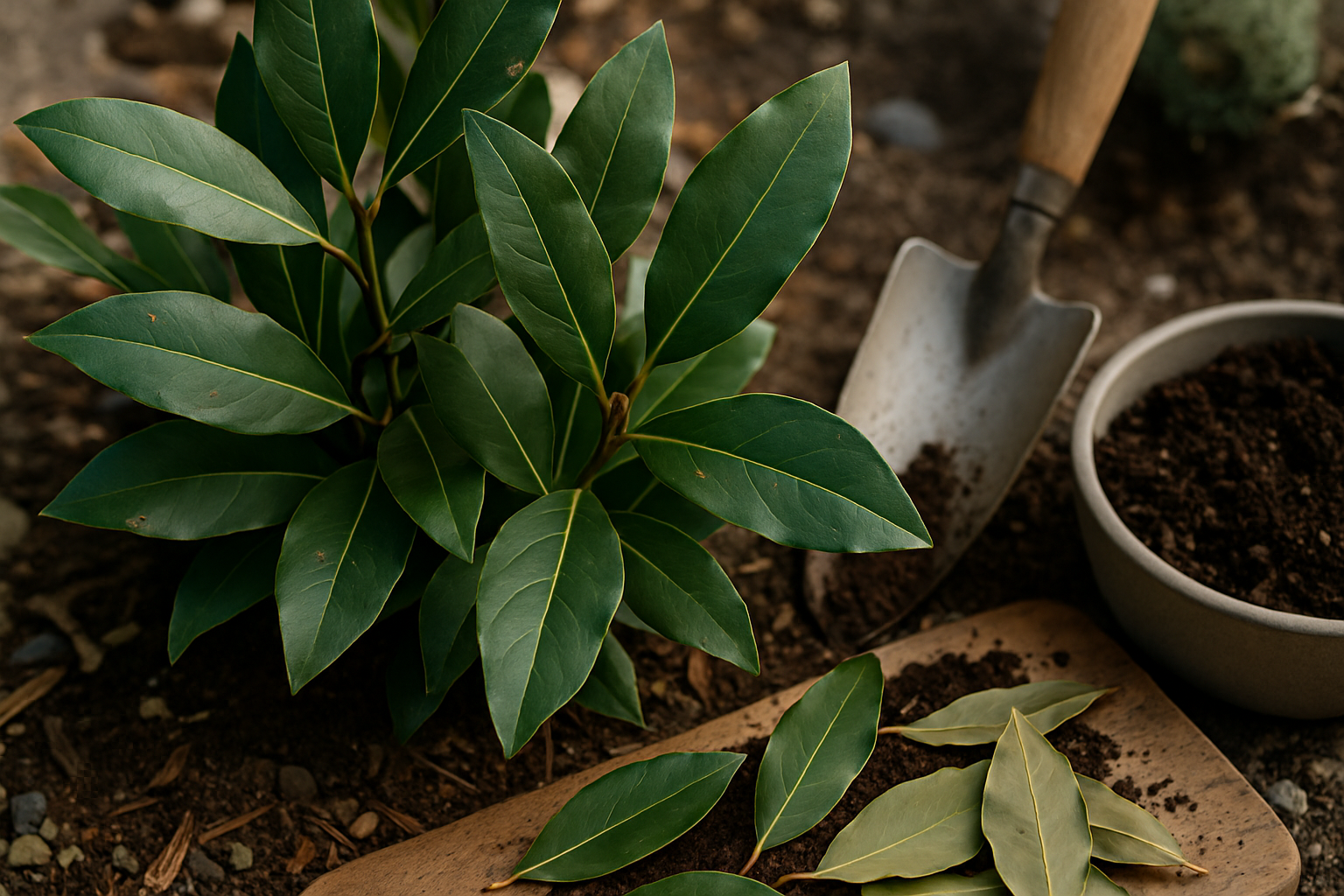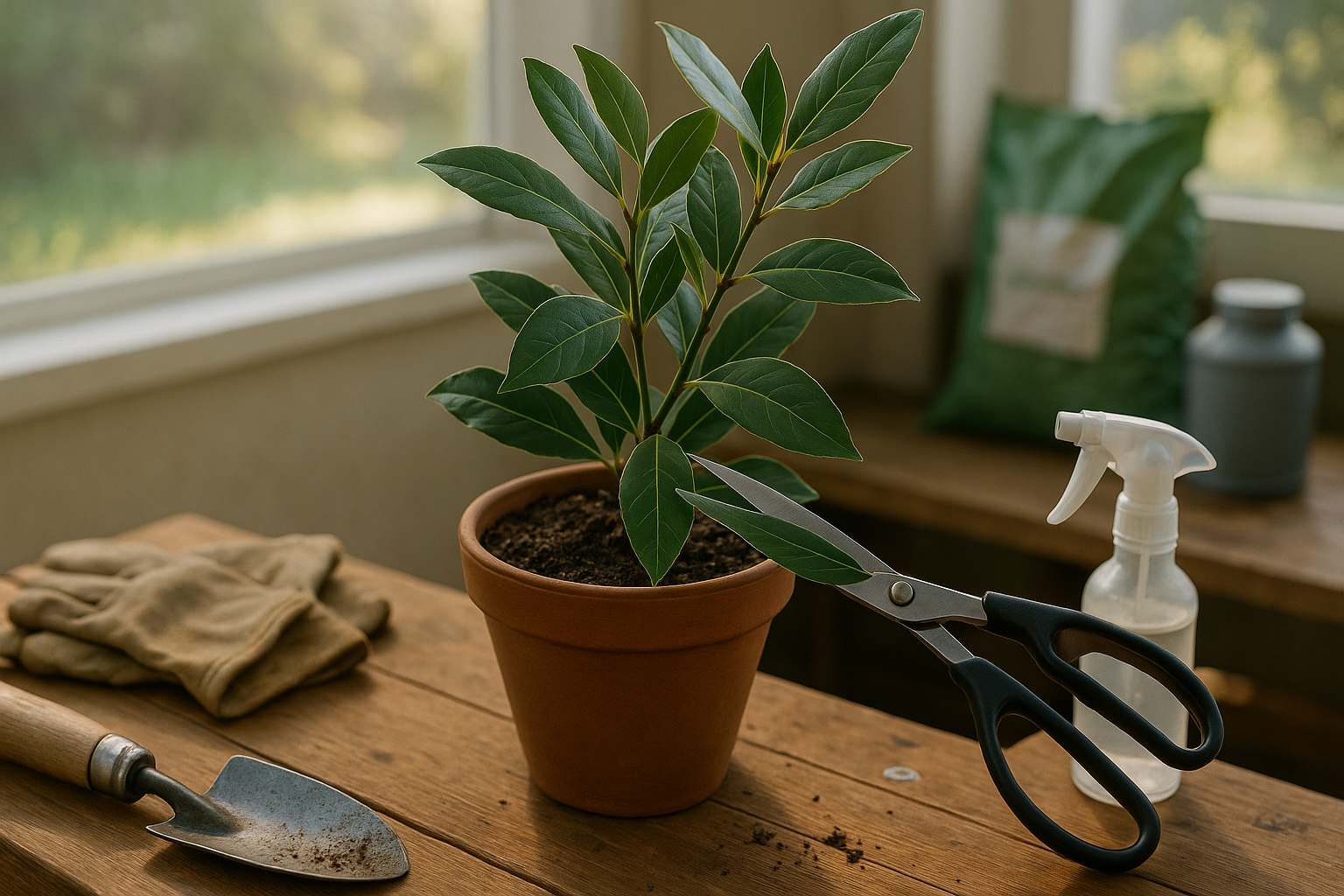Introduction
Growing bay leaf year-round is a goal for many home cooks and gardeners, thanks to the versatility of bay laurel (Laurus nobilis). This aromatic evergreen shrub is more than just a kitchen staple—its glossy leaves add rich, subtle flavors to soups, stews, and roasts. It’s cherished worldwide for both culinary and medicinal purposes. Beyond the kitchen, dried bay leaves are used in potpourri and even as natural pest deterrents, making them a valuable addition to any home.
For anyone who enjoys cooking from scratch or relies on herbal remedies, a steady supply of fresh bay leaves can be a game-changer, sparking widespread interest in growing bay leaf year-round.
But is it really possible to enjoy fresh bay leaves in every season? The good news: bay laurel is surprisingly adaptable, thriving both outdoors in mild climates and indoors in pots for those with colder winters. This article will guide you through everything you need to know—choosing the best growing conditions, providing consistent year-round care, and overcoming climate challenges, whether you have a sunny garden plot or just a bright windowsill. We’ll explore practical solutions for different regions so you can keep your bay laurel happy, healthy, and productive all year long.
Understanding Bay Laurel and Its Growing Needs

Bay laurel (Laurus nobilis) is a famously aromatic evergreen shrub or small tree, best known for its glossy, dark green leaves that enhance countless Mediterranean and global dishes. Unlike faster-growing herbs, bay laurel grows slowly, often reaching 10 to 30 feet over many years if left unpruned. This leisurely pace makes it an attractive, low-maintenance addition to gardens and patios.
Beyond its culinary appeal—flavoring soups, stews, and sauces—dried bay leaves also serve household uses like natural pest deterrents and potpourri ingredients. For optimal health, bay laurel thrives in climates similar to its Mediterranean home: mild, frost-free winters, full sunshine, and soil with excellent drainage are key.
It is hardy in USDA zones 8 to 10, tolerating occasional light frosts but suffering in prolonged freezes. Gardeners in cooler regions often grow bay in containers for easy relocation indoors during cold snaps. In warmer zones, planting directly in the ground lets bushes mature to their full, lush potential. Always ensure potted bays have enough root space and well-draining soil, as they dislike soggy conditions.
Confusion can arise with unrelated “bay” species, such as California bay (Umbellularia californica) or cherry laurel (Prunus laurocerasus), which look similar but differ significantly in flavor, aroma, and sometimes toxicity. For authentic culinary use and safety, seek Laurus nobilis specifically, checking plant labels in nurseries if needed.
With a little patience and the right growing setup, bay laurel can supply both flavor and greenery to your home for years to come.
Outdoors vs. Indoors
Bay laurel thrives outdoors in regions with mild, Mediterranean-like climates where winters aren’t too harsh. It prefers well-draining soil, shelter from strong winds, and a spot that gets at least six hours of sunlight daily. In areas prone to frost, bay laurel can struggle—so gardeners often use microclimates, such as planting next to a south-facing wall or under a porch, to provide extra warmth and protection.
During colder spells, draping shrubs with horticultural fleece or frost cloth helps prevent leaf damage, while adding mulch around the base insulates the roots. For those living in cooler or less predictable climates, growing bay laurel in containers is a smart alternative that allows for year-round care.
Containers make it easy to move the plant outdoors in spring and summer for fresh air and maximum sunlight, then bring it indoors to a sunny window or unheated sunroom as temperatures drop. When transitioning between indoors and outdoors, always acclimate your bay laurel gradually—taking about a week to adjust to new light and temperature conditions—to prevent leaf scorch or drop.
Choose a pot with drainage holes and use a light potting mix to avoid root rot, watering only when the top inch of soil feels dry. Regularly prune container plants to keep them compact and remove any dead leaves.
This flexibility means gardeners in cooler, non-Mediterranean regions can enjoy fresh bay leaves year-round by using containers and smart seasonal moves to mimic the bay laurel’s ideal Mediterranean environment.
Essential Year-Round Bay Laurel Care

Proper year-round care keeps bay laurel healthy and aromatic, starting with smart watering. Bay laurels prefer their soil to dry out slightly between waterings, so check the top inch of soil before adding water—too much moisture risks root rot, especially in cool months.
During active spring and summer growth, water once the soil feels dry to the touch. In autumn and winter, cut back, watering only when absolutely needed. Fertilize with a balanced, slow-release fertilizer in early spring and again in midsummer, but avoid feeding during the dormant late fall and winter months since overfeeding can burn roots and weaken your plant.
Pruning should be done in late winter or early spring to control size and shape—snip just above leaf nodes and remove any dead or crossing branches. Regular pruning not only helps manage the plant’s size for containers or garden beds but also encourages dense, healthy new growth, perfect for harvesting aromatic leaves.
To prevent pests like scale insects and aphids or fungal diseases like powdery mildew, increase air circulation by avoiding overcrowding, wipe leaves occasionally with a damp cloth, and inspect your bay laurel frequently for any trouble. Spraying with horticultural oil in late winter can deter overwintering pests. If you spot signs of infestation or disease, promptly remove affected leaves and consider using an organic insecticidal soap.
Keeping your bay in a sunny, sheltered spot with well-draining soil and practicing these straightforward habits means you’ll enjoy lush, flavorful leaves throughout the year, whether you grow it inside or out.
Overwintering and Frost Protection
Protecting bay laurel from harsh winter conditions is crucial, especially in regions where temperatures dip below freezing. If you’re overwintering your bay laurel outdoors, wrap the plant with horticultural fleece or burlap to shield it from cold winds and frost. Secure the fabric loosely to allow air circulation, but make sure it covers the entire plant, especially during cold snaps.
For smaller bay laurel trees, consider placing them in a cold frame or an unheated greenhouse to provide consistent shelter—this can significantly improve the plant’s chances of survival. When a late frost is expected, quickly cover the plant with breathable fabric or move potted bays against a sheltered wall for extra warmth.
If temperatures drop suddenly, water the plant’s roots (but avoid overwatering), since moist soil retains more heat than dry. Mulch heavily around the base with straw or bark to help insulate the roots.
For gardeners planning to move bay laurel indoors, start by placing it in a shady, sheltered spot outdoors for a few days before bringing it inside to a bright, cool room. Avoid exposing the plant to hot, dry air from radiators. Gradually reduce watering, but don’t let the soil dry out completely.
Watch for signs of winter stress such as yellowing leaves, leaf drop, or browning tips. These may indicate cold damage, transplant shock, or lack of humidity. If this occurs, increase humidity by misting the leaves, trim off any damaged foliage, and ensure the plant isn’t exposed to drafts or sudden temperature changes.
Regularly check for pests, as weakened bay laurels are more vulnerable during these stressful months.
Harvesting Bay Leaves All Year
To enjoy a steady supply of aromatic bay leaves year-round, timing and technique are key. The best practice is to harvest in spring or early summer, just after new growth appears, but you can pick leaves as needed throughout the year.
Choose mature leaves—usually those that are deep green, leathery, and at least a year old—for the richest flavor and potency. Younger, lighter-green leaves tend to be milder and more delicate.
Always use clean, sharp scissors or garden snips to clip individual leaves, taking no more than a third of the plant at one time. This encourages steady regrowth and prevents shock.
To maximize shelf life, rinse the leaves briefly and pat them dry. Then spread them in a single layer on a baking sheet or mesh rack in a cool, dry, well-ventilated space, out of direct sunlight. Leaves will be fully dried in about seven to ten days, becoming crisp while retaining their color.
Store the dried leaves in an airtight container away from light and heat—think glass jars in a pantry cupboard—to preserve their aroma for up to a year.
By harvesting lightly every few months rather than stripping the plant bare, you keep your bay tree healthy and productive while always having fresh leaves at hand for soups, stews, or homemade spice blends.
Troubleshooting Common Problems
Even experienced plant owners encounter issues like leaf spots, yellowing leaves, root rot, and pest infestations such as scale or aphids.
Leaf Spots
Leaf spots often signal too much moisture or poor air circulation. Try watering at the soil line and spacing plants to improve airflow.
Yellowing Leaves
Yellowing leaves can indicate overwatering, nutrient deficiencies, or too little sunlight. Double-check your plant’s care requirements and adjust your routine as the seasons change.
Root Rot
If you notice mushy stems or a musty smell, root rot might be developing. Remove the plant from its pot, trim affected roots, and repot in fresh, well-draining soil.
Pest Infestations
Pest problems are common, too. Scale insects appear as tiny bumps on stems, while aphids cluster on new growth. Prune heavily infested areas, wash plants under lukewarm water, and use insecticidal soap if needed.
Prevention and Early Intervention
- Regularly inspect leaves.
- Clean pots and tools.
- Maintain proper watering habits.
Intervene quickly at the first signs of trouble—catching issues early makes recovery easier and keeps your plants thriving all year long.
Conclusion
With the right conditions—ample sunlight, well-draining soil, and occasional pruning—bay leaf can thrive indoors or outdoors all year round. Growing bay laurel isn’t just rewarding; it’s easy to fit into most patios, kitchens, or gardens, making it a versatile addition to your home.
Regular watering, protecting the plant from harsh frost, and ensuring good air circulation will keep it healthy through every season. If you’ve ever wanted fresh, aromatic leaves for cooking or natural décor, now’s the perfect time to try.
With a little attention, you’ll enjoy fresh bay leaves whenever you need them, straight from your own plant.
